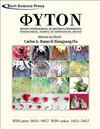Ectopic expression of the PttKN1 gene in Cardamine hirsuta mediated via the floral dip method.
IF 1.2
4区 生物学
Q3 PLANT SCIENCES
Phyton-international Journal of Experimental Botany
Pub Date : 2016-10-03
DOI:10.32604/phyton.2015.84.368
引用次数: 1
Abstract
PttKN1 gene (Populus tremula × P. tremuloides KNOTTED1) was isolated from the vascular cambium of a hybrid aspen. Previous studies on transformed plants with the PttKN1 gene suggested that it plays roles in plant development (typically in meristem initiation), maintenance and organogenesis in simple-leaved species. To investigate the gene functions further, sequence analysis of the deduced amino acid was conducted. The results suggested that the gene belongs to the class I KNOX gene (KNOTTED1-like homeobox genes) family and might play important roles in plant development by coding a transcription factor. The gene was introduced into Cardamine hirsuta using the floral dip method mediated via Agrobacterium tumefaciens. The primary transformed plants were obtained via kanamycin selection. Compared to the wild type, the kanamycin resistant plants demonstrated several morphological alterations, such as abnormal cotyledons, abnormal shoot meristem, flattened stem, and lobed and cup-shaped leaves. RT-PCR results showed that the above five types of kanamycin resistant plants expressed the same specific PttKN1 gene band. This suggested that the morphological alterations were caused by the insertion and expression of the gene. However, these phenotypes were similar to other PttKN1 transformed plants, despite the fact that C. hirsuta is a species with compound leaves and the other species have simple leaves. Therefore, the functions of the PttKN1 gene on compound-leaf species have yet to be investigated via the comparison between related species such as Arabidopsis thaliana and C. hirsuta.花浸渍法介导小豆蔻碱多毛PttKN1基因的异位表达
从杂交白杨维管形成层中分离到PttKN1基因(Populus tremula × P. tremuloides knottted1)。先前对携带PttKN1基因的转化植物的研究表明,它在单叶植物的发育(主要是分生组织的起始)、维持和器官发生中发挥作用。为了进一步研究该基因的功能,对推导出的氨基酸进行了序列分析。结果表明,该基因属于I类KNOX基因家族,可能通过编码转录因子在植物发育中发挥重要作用。通过农杆菌介导的花浸渍法将该基因导入小豆蔻毛菌。通过卡那霉素选择获得初级转化植株。与野生型相比,卡那霉素抗性植株表现出一些形态变化,如子叶异常、芽分生组织异常、茎扁平、叶裂和杯状。RT-PCR结果显示,上述5种卡那霉素抗性植物表达了相同的PttKN1特异性基因带。这表明形态学改变是由该基因的插入和表达引起的。然而,这些表型与其他PttKN1转化的植物相似,尽管毛缕草是复叶物种,而其他物种是单叶物种。因此,PttKN1基因在复叶物种上的功能还有待通过拟南芥和毛毛芥等近缘种的比较来研究。
本文章由计算机程序翻译,如有差异,请以英文原文为准。
求助全文
约1分钟内获得全文
求助全文
来源期刊
CiteScore
1.90
自引率
11.80%
发文量
17
审稿时长
12 months
期刊介绍:
Phyton-International Journal of Experimental Botany is an international journal that publishes on the broadest aspects of plant biology and ecology. The journal welcomes the original and exciting submissions that provide new and fundamental insights into the origins, development, and function of plants from the molecular to the whole organism and its interactions within the biotic and abiotic environment. Phyton-International Journal of Experimental Botany publishes outstanding research in the plant and ecology sciences, especially in the areas of plant physiology and biochemistry, plant metabolism, plant ecology and evolution, as well as those making use of synthetic, modeling, bioinformatics, and -omics tools. Manuscripts submitted to this journal must not be under simultaneous consideration or have been published elsewhere, either in part or in whole.

 求助内容:
求助内容: 应助结果提醒方式:
应助结果提醒方式:


